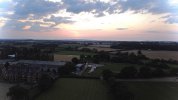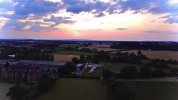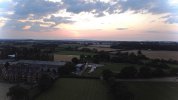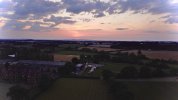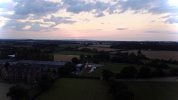You are using an out of date browser. It may not display this or other websites correctly.
You should upgrade or use an alternative browser.
You should upgrade or use an alternative browser.
Preference?
- Thread starter TheSnowyPilot
- Start date
CorralesDan
Well-Known Member
The first/left is my choice as it’s more natural. The second is a little more saturated for my taste.
Cool shot. Somewhere between the two would probably be best.
Not sure what you are using the edit your pictures, but you might consider reducing the highlights and increasing the shadows, for a greater range of colours/detail
Not sure what you are using the edit your pictures, but you might consider reducing the highlights and increasing the shadows, for a greater range of colours/detail
Saladshooter
Well-Known Member
Somewhere between the two shots....The first is more natural but lacks much pop.... the second is obviously oversaturated as you intended.
Shadows, black point, or vignette? To be increased that is.Cool shot. Somewhere between the two would probably be best.
Not sure what you are using the edit your pictures, but you might consider reducing the highlights and increasing the shadows, for a greater range of colours/detail
Perfect place for a bracketed exposure and post processing the multiple exposure in Lightroom HDR
These two should be somewhere in the middle?
And how so ‘bracketed’?Perfect place for a bracketed exposure and post processing the multiple exposure in Lightroom HDR
Attachments
Increase the shadows. I’d leave the other twoShadows, black point, or vignette? To be increased that is.
The Mavic 2 pro has a photo setting for shooting 3 or 5 photos in rapid sequence each at a different exposure value. For example first shot as “normal base” next one -2 stops then -1 stop next plus 2 stops. This function will give you 3 or 5 raw and or JPEG photos some of these images have the shadows well exposed with blown highlights and others will have perfect highlights with just black shadows. Software in photoshop, Lightroom, perhaps Luminar and others offering HDR PROCESSING (high dynamic range) will do the trick. The DJI web site has instructions on what and how to do this. I use this for most low light still photos taken at sunrise/sunset. I believe all DJI cameras and software can take these grouped photos For you. One button push and 5 differently exposed images are on your SD card.These two should be somewhere in the middle?
And how so ‘bracketed’?
You bring good examples that will accelerate your learning. You brought a really complex example this time. Again, I have placed a histogram (captured before the corrections I did) and you can see that it is up against both the right and left sides, and spiked in the over-exposed category. Still the shadows are underexposed. This can be a challenge for any sensor because every sensor has limitations as to how many F stops of information it can capture in one image. In this case the overexposure of the sky isn't too bad because there is no detail in the bright spots and there is enough color that a saturation boost can (and does) help. However, while I was able to resurrect shadow detail, there is a ton of noise, far more than is acceptable.
But you've confused me. I downloaded both images and the meta data says that both images have exactly the same exposure. You may have PROCESSED the images at two different levels, but they are identical in terms of EXPOSURE. See the lower image and look in the red circled area to see the data.
For more help, please provide more detailed information about what you do, which program you use after your images are downloaded to your computer.
What is the answer: Shoot multiple images at different exposures and merge them in post production. A term you might familiarize yourself with is HDR (high dynamic range) capture... In other words, multiple exposures then merged (and masked). Sometimes capturing images in raw format can be acceptable. Your drone's camera is only capable of capturing so much information in the highlights and shadows, so sometimes (often) it is necessary to expose for each of those elements separately.
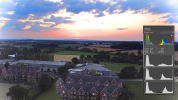
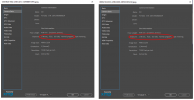
But you've confused me. I downloaded both images and the meta data says that both images have exactly the same exposure. You may have PROCESSED the images at two different levels, but they are identical in terms of EXPOSURE. See the lower image and look in the red circled area to see the data.
For more help, please provide more detailed information about what you do, which program you use after your images are downloaded to your computer.
What is the answer: Shoot multiple images at different exposures and merge them in post production. A term you might familiarize yourself with is HDR (high dynamic range) capture... In other words, multiple exposures then merged (and masked). Sometimes capturing images in raw format can be acceptable. Your drone's camera is only capable of capturing so much information in the highlights and shadows, so sometimes (often) it is necessary to expose for each of those elements separately.


I use the photos app on my iPhone. Any more shadow than what I put in makes it look black.You bring good examples that will accelerate your learning. You brought a really complex example this time. Again, I have placed a histogram (captured before the corrections I did) and you can see that it is up against both the right and left sides, and spiked in the over-exposed category. Still the shadows are underexposed. This can be a challenge for any sensor because every sensor has limitations as to how many F stops of information it can capture in one image. In this case the overexposure of the sky isn't too bad because there is no detail in the bright spots and there is enough color that a saturation boost can (and does) help. However, while I was able to resurrect shadow detail, there is a ton of noise, far more than is acceptable.
But you've confused me. I downloaded both images and the meta data says that both images have exactly the same exposure. You may have PROCESSED the images at two different levels, but they are identical in terms of EXPOSURE. See the lower image and look in the red circled area to see the data.
For more help, please provide more detailed information about what you do, which program you use after your images are downloaded to your computer.
What is the answer: Shoot multiple images at different exposures and merge them in post production. A term you might familiarize yourself with is HDR (high dynamic range) capture... In other words, multiple exposures then merged (and masked). Sometimes capturing images in raw format can be acceptable. Your drone's camera is only capable of capturing so much information in the highlights and shadows, so sometimes (often) it is necessary to expose for each of those elements separately.
View attachment 134997
View attachment 134998
- Joined
- May 25, 2017
- Messages
- 8,476
- Reactions
- 7,966
- Age
- 63
Looks better than the first original and edited photos.
You got rid of the grainy look.
Not much more you can probably do in that low light situation.
The histogram on the editing suite posted a couple of times.
Can't remember what you're flying, but if you can get the histogram up on the device screen (menu settings), maybe you can help take a better base photo in the first place.
Look up some histogram tutorials on YouTube if you're not sure what you are aiming for on the histogram chart.
You got rid of the grainy look.
Not much more you can probably do in that low light situation.
The histogram on the editing suite posted a couple of times.
Can't remember what you're flying, but if you can get the histogram up on the device screen (menu settings), maybe you can help take a better base photo in the first place.
Look up some histogram tutorials on YouTube if you're not sure what you are aiming for on the histogram chart.
I fly a Mini.Looks better than the first original and edited photos.
You got rid of the grainy look.
Not much more you can probably do in that low light situation.
The histogram on the editing suite posted a couple of times.
Can't remember what you're flying, but if you can get the histogram up on the device screen (menu settings), maybe you can help take a better base photo in the first place.
Look up some histogram tutorials on YouTube if you're not sure what you are aiming for on the histogram chart.
- Joined
- May 25, 2017
- Messages
- 8,476
- Reactions
- 7,966
- Age
- 63
I fly a Mini.
Almost certain you can get the histogram on your screen with the Mini and Fly app.
A toggle in settings to have it visible.
You need a stand-alone application for your COMPUTER. You will never get great photos out of your phone. 1) Your phone is not calibrated nor in a constant lighting environment. 2) The amount of adjustment in your phone is severely limited, especially for images that have a large dynamic range. There is no substitute for using the right tools for a given job... and your phone is not it.I use the photos app on my iPhone. Any more shadow than what I put in makes it look black.
I am not a fan of Adobe (largely because of their pricing scheme) and IMO the best/cheapest substitute application for photo editing/processing, like Photoshop, is Affinity Photo. $50. It operates very much like Photoshop, but there is a bit of a learning curve, just like Photoshop. Alternately, if you don't need fancy editing capability or need something easier I would recommend On1 Photo Raw. They are just coming out with their 2022 version. $99 (and there are 20% off coupon codes available if you look... I think "NIKONRUMORS" will work). It has almost everything that Adobe Lightroom has, gives up a few minor features and has a few more minor features. They do have an inexpensive subscription model, $8/mo, but I prefer just to buy the license and skip the software rental nonsense.
Most importantly, it takes some learning and studying to understand what you want out of your images. You're on the right track there asking questions. It's not hard, but the learning process doesn't happen overnight. Lots of trial and error. The good news is, unlike the old film and paper days, it doesn't cost an arm and leg in film and processing and in-person sharing to learn.
Twocalf
Well-Known Member
I agree with many of the suggestions that have been made. I'm not sure I caught which drone you're using to capture the still images but I highly endorse what DougMcC had to say about bracketed shots. If your drone's camera is capable of bracketed shots then by all means do so and make sure you're at least capturing RAW images and I'd consider not capturing the associated jpeg's because they are essentially worthless. DougMcC mentioned Lightroom and Luminence as software that will allow you to merge those 3 or 5 images (I'd recommend 5) using HDR methodolgy into the best overall exposure that might be possible. The darkest regions of the frame are best captured by the most overexposed image while the brightest part of the frame is best captured by one of the underexposed images. The HDR software does an amazing job of getting the best out of each image and merging them into something special you can't really capture in a single frame especially the way our eyes see it in real time. Good luck!
If you see my earlier reply with images, the metadata suggests there was only ONE exposure, just edited- one brighter, one version darker. Also see my comments regarding On1 Photo Raw vs Lightroom. Fwiw I have a subscription to Photoshop/Lightroom and prefer O1PR to Lightroom-by a lot.I agree with many of the suggestions that have been made. I'm not sure I caught which drone you're using to capture the still images but I highly endorse what DougMcC had to say about bracketed shots. If your drone's camera is capable of bracketed shots then by all means do so and make sure you're at least capturing RAW images and I'd consider not capturing the associated jpeg's because they are essentially worthless. DougMcC mentioned Lightroom and Luminence as software that will allow you to merge those 3 or 5 images (I'd recommend 5) using HDR methodolgy into the best overall exposure that might be possible. The darkest regions of the frame are best captured by the most overexposed image while the brightest part of the frame is best captured by one of the underexposed images. The HDR software does an amazing job of getting the best out of each image and merging them into something special you can't really capture in a single frame especially the way our eyes see it in real time. Good luck!
- Joined
- May 25, 2017
- Messages
- 8,476
- Reactions
- 7,966
- Age
- 63
I'm not sure I caught which drone you're using to capture the still images
I think the OP had an original mini, post #15, so no raw.
Similar threads
- Replies
- 5
- Views
- 1K
- Replies
- 2
- Views
- 607
- Replies
- 3
- Views
- 1K
- Replies
- 1
- Views
- 848
DJI Drone Deals
New Threads
-
Hiring Remote Drone Pilots and Support Staff with CrewBloom
- Started by felixleo
- Replies: 1
-
3 Along the road to my daughters former school
- Started by alex_markov
- Replies: 0
-
Last Week's Most Popular Topics (December 13, 2025)
- Started by msinger
- Replies: 0
-
Members online
Total: 3,390 (members: 9, guests: 3,381)




